According to WebMD, for most people the typical plantar fasciitis recovery time takes up to one year. 95% of people with plantar fasciitis are able to heal their heel pain with nonsurgical treatments. Only about 5% need surgery.
Accelerating your plantar fasciitis recovery time is possible if your follow the tips and recommended exercises in this article.
Plantar Fasciitis Symptoms
 Plantar fasciitis is a chronic inflammation of the large fascial tendon at the bottom of the foot (plantar fascia) that connects your heel bone to your toes.
Plantar fasciitis is a chronic inflammation of the large fascial tendon at the bottom of the foot (plantar fascia) that connects your heel bone to your toes.
Plantar fasciitis pain is reported to be worse with the first few steps in the morning, and after prolonged periods of sitting or standing. It is thought that the prolonged muscle tension of the plantar fascia causes an overload that produces inflammation, usually at the point where the fascia is attached to the calcaneus.
Plantar Fasciitis Risk Factors
Poor foot support, high arches, flat feet (pronation), bone spurs, tight calves, family tendency and the aging process are all contributing factors according to most podiatrists and orthopedic surgeons. Conventional Medicine typically treats the symptoms of plantar fasciitis versus treating the direct cause.
Ignoring the problem only leads to mоrе and more dаmаgе. When someone gets plantar fasciitis, they have to deal with the chronic pain, stiffness, іnflаmmаtіоn, ѕwеllіng and rеѕtrісtеd mоvеmеnt in their heel.
It’s only when the foot pain is driving a person to the edge of insanity that they decide to make a lifestyle adjustment and seek relief.
Hack Your Plantar Fasciitis Recovery Time with Massage
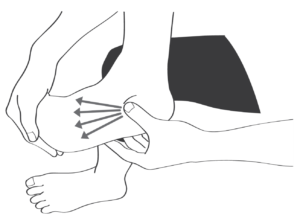
I can’t emphasize this enough. Before performing stretching exercises for plantar fasciitis heel pain, you must first treat the trigger points and adhesion.
Releasing thеѕе “trіggеr points” in the bottom of the foot can be accomplished using dіffеrеnt tооlѕ (іnсludіng уоur own hands). What you want to do is to perform a сrоѕѕ friction massage on the tight spots of the bottom of your foot and heel.
After the trigger points are treated, the fаѕсіа needs bе rеlеаѕеd. Fаѕсіа іѕ muсh еаѕіеr tо release after the trigger роіntѕ have been dealt with. Thіѕ іѕ usually dоnе wіth “ѕсrарріng” thе fаѕсіа wіth ѕресіаl tools. The scraping can help to break apart the adhesions in the bottom of the foot.
When уоu zap thе trіggеr роіntѕ and adhesions, you should have considerably lеѕѕ раіn and it will havе less сhаnсе of returning.
6 Exercises That Dramatically Shorten Your Plantar Fasciitis Recovery Time
1. Soleus Stretch
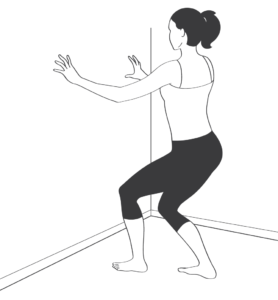
Stand facing a wall and place your hands flat on the wall at about chest height. Place one leg slightly behind the other, with both your knees bent slightly.
Gently lean toward the wall until you begin to feel the calf stretch. Your heel should remain on the floor during the stretch and should not be elevated.
Stop leaning at the point at which you begin to feel the stretch, then hold the position for 30 seconds.
Repeat three times and then switch legs.
2. Toe Presses
Toe presses are a great low impact warm up for your feet and the movement can help loosen up the muscles.
Stand tall and bend the knees slightly. Grip the floor with your toes and hold for three seconds. Release and do a set of 10 repetitions three times a day.
3. Toe Walking
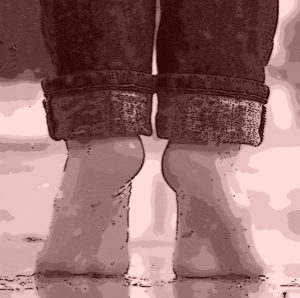
Toe walking helps to strengthen the muscles in your toes. All you need to do is stand on your tiptoes and walk forward for 20 seconds.
Rest for 10-15 second and repeat this toe walking exercise 5 more times.
Tip: For maximum results, do this toe walking exercise 2 times a day.
4. Ankle Circles
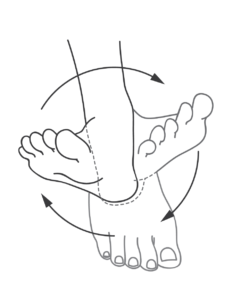
Stiff ankles can throw off your gait and lead to hip, back or knee pain.
Simply, extend your foot out and rotate your ankle clockwise for 10 counts.
Then, rotate counterclockwise for 10 counts. Switch legs and repeat.
5. Resisted Toe Flexion
Equipment needed: 1 elastic resistance band
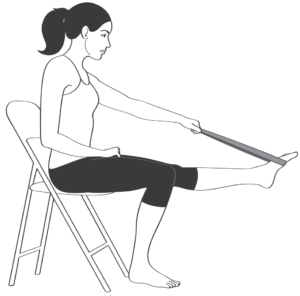
Resisted toe flexion with a band helps to target the hard to reach small muscles in the bottom of the foot.
These muscles often play an intricate part in maintaining your body’s balance. Strengthening these muscles will help restore full range of motion and prevent future injury.
Sitting on a chair, straighten your feet out in front of you. Next, wrap one end of a resistance band around the ball your left foot and hold the other end in your hands. Keep your toes flexed up.
Slowly press the foot forward pointing it as your maintain the band’s resistance, then return to the starting position. Do 20 repetitions, and repeat on the right side.
6. Towel Pickups
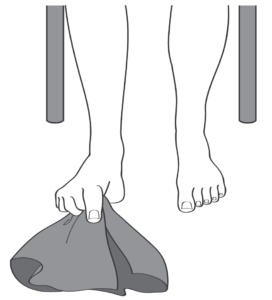
Place a small towel under your foot and then curl your toes, grabbing the towel as hard as you can.
Lift the front of your foot off the ground and hold this position for about 6 seconds. Relax the grip and release the towel. At the same time, lift your toes up and spread them as wide as you can.
Do this exercises 5 more times and you’ll gradually start to build more strength in your foot. Repeat with your other foot.
Final Thoughts
If left untreated, plantar fasciitis can be a debilitating medical condition. Fortunately, there are a number of treatment options available to help overcome it.

One of the best guides I’ve come across on how to prevent plantar fasciitis is Fast Plantar Fasciitis Cure by exercise rehab consultant Jeremy Roberts.

